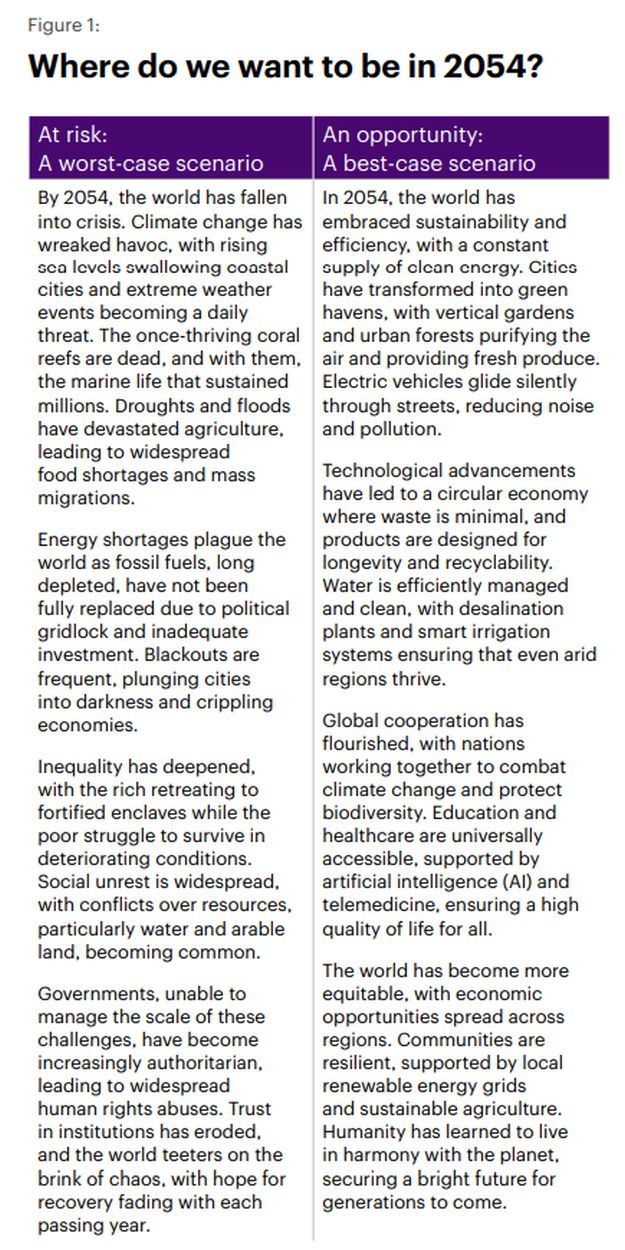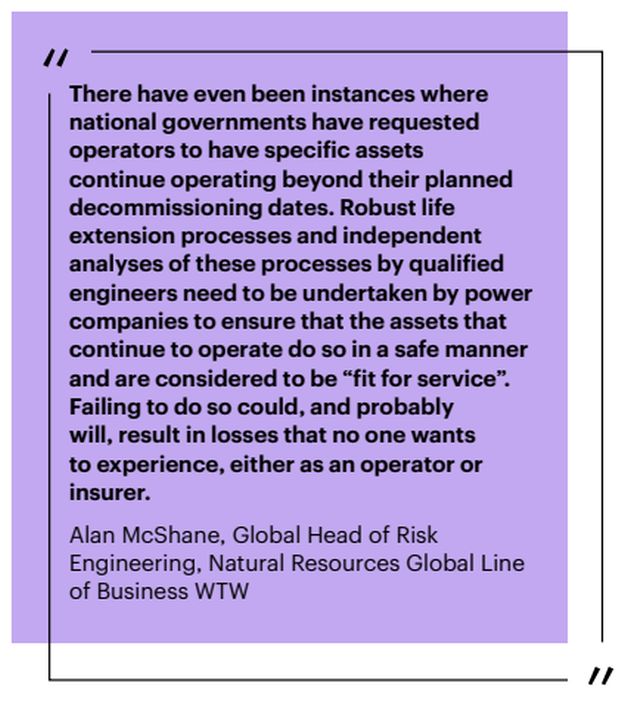Power generation is at the heart of the energy system, providing critical systems and infrastructure as the world electrifies and evolves. Energy use could double by the end of the century1 , with geopolitical tensions, new technologies, a changing climate and variable economic outlooks all key drivers influencing the direction and pace of change.
Imagining that future is hard but the scale of change could be huge. 30 years ago, life looked very different. In 1990s 3.5" floppy disks were still in use2 , the smart phone was still nearly two decades away, Google was an idea in a university dorm room called Backrub3.
Getting the balance right: Power are acutely aware of what's at stake
Whether the future is a risk or an opportunity will depend on power companies' business goals and risk management strategies. The momentum behind electrification is growing. And risk leaders are challenged in making the right decisions today, to build a better tomorrow for their business.
While forecasting involves predicting the future based on current trends, backcasting approaches planning from a future perspective. If you set your objectives, you know what steps need to be taken to get there. By backcasting, power companies can stay agile in responding to challenges with the end goal in mind.

1. Electrification and networks
The bottom line is global grid capacity needs to grow 2.5 times its current size, with annual expenditure on grids more than doubling to $970 billion by 20504 to achieve the goals of the Paris Agreement to keep global warming to no more than 1.5°C.
While the technologies to diversify energy production are still at different stages of development, more energy users will be adopting decentralized energy generation, storage and flexibility. Power companies increasingly support residential and commercial customers with solar panel installations, battery storage, and energy management systems, allowing them to make the most of available generation and network capacity by generating and managing their own energy
Connecting these networks together is a key area of focus. Bloomberg New Energy Finance (BNEF) estimate that 152 million kilometers of power lines may be needed for the world to reach net-zero by 20505.
Some of the most ambitious interconnector projects are looking to cross ever-greater distances to connect different regions with renewable energy potential: Xlinks is an interconnector project that would link Morocco and the United Kingdom; Elmed will link Italy and Tunisia; and EuroAfrica would link Greece, Cyprus and Egypt6. A 5,100km power link running from the Australian outback to Singapore is also on the table, alongside The North Atlantic Transmission One7 , aiming to connect North America to Western Europe via Eastern Canada and UK & Ireland. Not all of these will get off the ground, with obstacles of financing, critical metals and mineral availability, new technologies and transportation needed, but set out the scale of the action needed. From considering cross-border agreements to regulation and market design, change is needed at every level.

2. Demand and consumption
Power demand and consumption are becoming more dynamic and complex, driven by electrification, digitalization, energy efficiency improvements, societal values, and the growing role of renewable energy. Projections by the IEA8 have set out potential futures and energy-mix scenarios for a different demand and consumption changes which are already in action. IEA are also responding to rapid change, and will hold a special session later this year to discuss the explosion of AI and its impact on power consumption.
Computers accounted for 1-2% of global electricity use in 2018 and are projected to hit 8-21% by 20309 . Updated regulations and technological improvements, including on efficiency, will be crucial to moderate the surge in energy consumption from data centres.
Yet AI and advanced computing will be needed to support real-time data and analytics, bring about grid management and stability, support energy trading and market participation, and optimize storage and flexibility. The use of algorithms and forecasting by the industry is not new, but the use-cases are expanding. Policy makers around the world are at different stages of commercial deployment of AI applications in the electricity system, with security, ethics, reliability and trust at the centre of discussions. Interesting partnerships are in the works globally:
- In the UAE, the Department of Energy in Abu Dhabi has signed an10 to develop a highly efficient smart energy and power system utilizing diversified sources, especially clean and renewable energy.
- In Q2 2024 China filed 81% of the 1,640 global artificial intelligence related patent filed for the power industry, with SGCC responsible for 40311.
Governments are keen to support innovation for the industry. The U.S. Department of Energy recently awarded $3 billion in grants to various smart grid projects that include AI-related initiatives across 18 states to protect against growing threats of extreme weather events, lower costs for communities, and catalyze additional grid capacity to meet load growth stemming from an increase in manufacturing and data centers12.

3. Energy security and resilience
Progress to a more decentralized, decarbonized and digital energy system will be critical to meet evolving energy needs and build a growing network of smaller and more connected energy producers for energy security and resilience.
But major headwinds remain a threat. In July 2024, more than 2.6 million Texas power customers went without electricity for days in the summer heat as Hurricane Beryl hit the network14. Meanwhile, geopolitical events are putting a spotlight on the physical availability of hydrocarbons and coal, and the associated price volatility. It's no accident that the most consequential pieces of climate legislation in the U.S. and Europe to date — the U.S. Inflation Reduction Act (IRA) and the EU's Climate Law — arrived after Russia launched its invasion of Ukraine15.
A spotlight on Ukraine: Opportunities to build back better
RUSI reports16 that by mid-June 2024, conflict in Ukraine cumulatively destroyed 9 gigawatts (GW) of domestic power generation. At least 80% of Ukraine's thermal power and one-third of its hydroelectric power generation has been destroyed. Rebuilding power systems will create opportunities to reset the infrastructure to new standards; however, other organizations around the world are considering how best to optimize existing operations and when to invest in new assets to keep the lights on across the networks they power.
National governments are appreciating the role of power networks as critical national infrastructure, increasingly focusing on energy security.

Actions risk leaders need to take to drive value:
1. Identify your risks and opportunities, making use of industry specialization. Engaging with sector-focused risk and insurance specialists will be critical in protecting assets and positioning the company for the future. Risk leaders will be able to overlay potential sector-specific scenarios to test risk resilience and integrate lenses of risk and opportunity into strategic planning and enterprise risk management frameworks that consider possible futures.
2. Take an objective view of your resilience, backed by data. From managing and optimizing existing assets to considering new emerging technologies implemented from scratch, risk engineering monitors and analyzes global trends and their potential impact on business operations. Analytics will be key. The insights that well-designed risk models provide in a world of changing climates, higher frequency and severity natural catastrophe events, globalized distribution of higher value assets and more complex supply chains and revenue streams, to help risk leaders cut through complexity.
3. Optimize your insurance spend to deploy capital strategically. Analytics point to areas to retain risk that's costly in the market, or how best to spend on premium across all risks and set your limits at the most efficient level, in line with your organization's risk tolerance. Backed by these data-driven insights, risk and finance leaders can make informed decisions, knowing there will be no better option. Savings made on premium spend can then be deployed strategically in ways that best support the organization's future growth objectives.
Footnotes
1. https://www.iea.org/reports/electricity-2024/executive-summary
3. https://about.google/intl/ALL_uk/our-story/
4. https://www.dnv.com/news/dnv-new-power-systems-report/
5. https://about.bnef.com/blog/a-power-grid-long-enough-to-reachthe-sun-is-key-to-the-climate-fight/
6. https://www.euroafrica-interconnector.com/at-glance/
8. https://www.iea.org/reports/world-energy-outlook-2023/pathways-for-the-energy-mix#abstract
9. https://penntoday.upenn.edu/news/hidden-costs-ai-impending-energy-and-resource-strain
12. https://www.energy.gov/gdo/grid-resilience-and-innovation-partnerships-grip-program
13. https://www.rand.org/content/dam/rand/pubs/research_reports/RRA2900/RRA2907-1/RAND_RRA2907-1.pdf
15. https://www.wtwco.com/en-gb/insights/2024/06/green-competition-and-resource-nationalisation
The content of this article is intended to provide a general guide to the subject matter. Specialist advice should be sought about your specific circumstances.
[View Source]




